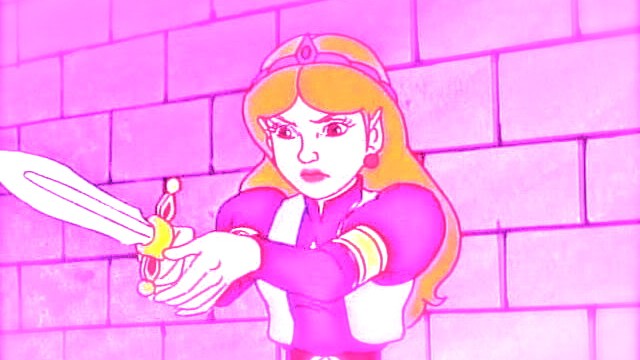
In many ways, Princess Zelda is rather like Princess Peach. Both have an uncanny predilection for getting kidnapped or imprisoned (I swear they must enjoy it occasionally); their respective kingdoms are constantly under attack from malicious forces; and they both have their own heroes ready and waiting to come and rescue them. However, Zelda has always had an edge, in my opinion. She’s often been shown to be a lot more resourceful and astute than her Mushroom Kingdom companion, and if her Sheikah disguise in Ocarina of Time wasn’t enough to convince the naysayers, then her appearances as Tetra in The Wind Waker and Phantom Zelda in Spirit Tracks should be more than enough to prove that this princess isn’t one to take an evil invasion lying down (well, except in Zelda II: The Adventure of Link, but that’s another story).
But even these three games, arguably her top three appearances in the entire Legend of Zelda series, all have their own flaws when it comes to depicting our dear princess. In Spirit Tracks she’s assassinated within the first hour, in The Wind Waker all of Tetra’s bravery seems to vanish the moment she transforms into Zelda, and Sheik can only act from the shadows in Ocarina of Time (not to mention that she also gets kidnapped the moment she lets her guard down). In the end, Zelda always manages to fall back into the typical damsel in distress stereotype at the last (and sometimes first) hurdle in every game. But there is one Zelda who constantly defies this fate, and that Zelda is the Zelda from The Legend of Zelda TV Series.
I know, I know– the only thing most people remember about the Zelda TV series is Link’s odious “Excuuuuuuse, me princess” catch-phrase and the nauseating voice-acting. You may even hang your head in shame at the very mention of it. But underneath all the silly plots and contrived dialogue lies at least one virtue which has perhaps been overshadowed by the show’s agonising awfulness, and that’s the creation of a Zelda who manages to stand head and shoulders above her royal sisters on every occasion.
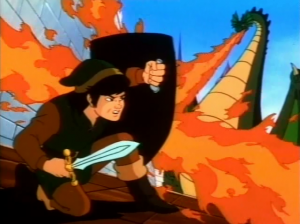
Although the TV series only had The Legend of Zelda and Zelda II to draw material from, it was the first time Zelda took a much more prominent, if not equal, role in Link’s adventuring. She may still have got captured a few times by Ganon (it wouldn’t really be Zelda if she didn’t, now would it?), but she definitely didn’t have to suffer the, as of then, usual story-long absence only to be rescued at the very end. No sir– this was a princess who fought Ganon and his minions front and centre alongside her hero in green, wielding her bow and boomerang (and the odd piece of fruit) with great skill and precision.
In the first episode alone she almost puts Link to shame when Ganon unleashes a dragon in the castle courtyard. Under the pretence of attending Hyrule’s amateur magician competition, Ganon transforms one magician’s lizard into a raging, fire-breathing monster so he can steal the Triforce of Wisdom. Upon hearing screams of peril down below, Link immediately dives out of his tower to save his princess, but he soon find himself trapped under his shield as the dragon unleashes a torrent of fire in his direction. Zelda, on the other hand, takes the initiative to remedy the situation by throwing a metal bowl into the air so Link can reflect his sword beams back at the monster while he defends himself.
With the dragon defeated, Ganon takes his cue to leave with the Triforce. Strangely, it’s Link who first begins to despair that they’ll never catch him once he reaches the gates. It’s perhaps slightly uncharacteristic for such a determined hero, but once again it’s Zelda who comes to the rescue. Spying a convenient hole in the ground, she gets one of the amateur magicians to use his growing spell on one of his seeds to turn it into a giant tree. She then fashions one of the branches into a make-shift catapault and hurls both Link and herself into the air to land in front of Ganon and his stalfos entourage. A double dose of Hylian ass-kicking ensues, Ganon is sent packing, and the Triforce is saved. She complements Link’s gun-ho style perfectly, and it’s probably safe to say that Link would have made a poor hero that day had it not been for Zelda’s cunning intuition.
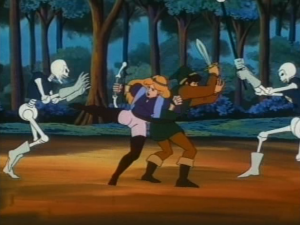
There are also many other occasions when Zelda demonstrates her superb fighting prowess, but the best example comes from Episode 4, “Kiss ‘N Tell”, when she singlehandedly fends off Gleeok, a three-headed dragon, to save a young maiden (with pieces of fruit no less). She’s definitely not one to cower and let Link have all the fun; she gets stuck right into the action and constantly refuses Link’s frequent requests to stand back and let him handle the situation– a far cry from the more passive princesses we’ve seen more recently in A Link to the Past, The Minish Cap, Four Swords Adventures, Twilight Princess, and even Spirit Tracks when you consider this memorable scene.
And while we’re on the subject of Spirit Tracks, the TV series actually prefigures the game’s events quite remarkably in Episode 12, “The Missing Link”– only this time the roles of spirit and hero have been reversed, laying bare how little Zelda’s character has moved forward (or even how much it’s regressed) if we compare it with Zelda’s hysterical assertions about accompanying Link on his adventure in Spirit Tracks. In “The Missing Link,” it’s Link’s spirit which gets separated from his body and it’s Zelda who must step in to restore him back to his old self. Moreover, Zelda must wield Link’s sword due to his rather ghostly disposition. With a little help from Link’s vocal coaching, she manages to infiltrate Ganon’s underworld lair and take down a whole host of stalfos henchmen on her own. She’s utterly fearless throughout her mission, never quaking at the sight of a mouse like Phantom Zelda as she marches down into the Underworld, and she doesn’t need a heavy suit of armour to do it. She takes the fight right to Ganon’s front door, and that’s something even Sheik couldn’t quite accomplish in Ocarina of Time. When push comes to shove, this is the princess you want by your side.
Of course, cartoon Zelda isn’t without her own share of character imperfections– she’s incredibly snotty on several occasions, she’s easily taken in by the charming yet vain Prince Facade in Episode 3, “The White Knight,” and she often screams far more than is really necessary. Most of us are probably quite glad that Nintendo didn’t decide to carry those particular traits forward into future games, but at least her vices and virtues are relatively consistent throughout the series.
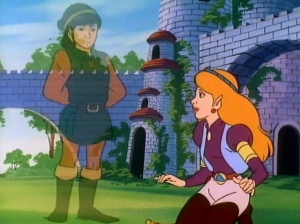
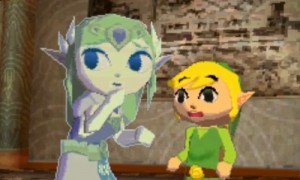
Waaaaaait a second, I think we’ve seen this plot before!
To put this in perspective with Zelda’s other more action-orientated appearances, one thing I’ve always found particularly disappointing with Tetra and The Wind Waker’s version of Zelda was how she suddenly went from being a bold as brass pirate to a fragile young girl who had to stay locked in the castle for her own safety. This was a girl who stormed the Forsaken Fortress and led a crew of burly men to stage a rescue operation! Even though Ganondorf put a swift end to her heroics, her courage seemed to completely melt away the moment she was revealed to be Zelda’s descendant. Up until that point she would have made a great case for the best interpretation of Zelda in the entire series, but this mannerism shift is too great a u-turn to ignore.
Likewise, one thing I’ve always wondered about Sheik was what she did in those intervening seven years. Granted, even cartoon Zelda needs Link’s help when taking down Ganon’s minions sometimes, but in Ocarina of Time it appears as though there’s been little or no attempt at all to lead any kind of rebellion against Ganondorf. Contrast this response to Episode 6, “That Sinking Feeling”– Zelda gets so frustrated by Ganon sinking things into the ground with the Overworld Magnet (including the whole of Hyrule Castle) that she goes to confront him head-on in the Underworld. I’ll admit that this scenario isn’t quite the same as a complete coup, but it doesn’t quite explain the discrepancy between Zelda’s adamant determination to stop Ganondorf as a child and then making no apparent effort to rescue her kingdom when she was old enough to do so. She might have saved Princess Ruto from the ice in Zora’s Domain and cleared up the mess in Kakariko Village when Bongo Bongo was released from the well, but you can’t deny that her efforts did very little to stem the tide of Ganondorf’s tyranny.
On the other hand, cartoon Zelda’s swashbuckling and tomboy-ish attitude certainly gets the job done when duty calls. We’ve had our fair share of damsels in distress over the past 25 years, and I think an iconic character like Zelda deserves a little more than to have some of her best moments relegated to this positively cringe-worthy TV show. Although it looks as though Zelda still gets kidnapped early on in the upcoming Skyward Sword, if her recent trend of securing bigger roles in games like The Wind Waker and Spirit Tracks is anything to go by, then perhaps there’s still hope that one day we might just see our beloved princess following in the footsteps of her animated ancestor– just as long as it isn’t a rehash of the CD-i Zelda’s Adventure!




 ShareThis
ShareThis







That pink graphic is a bit blinding…
I think half the reason why Zelda is so much more capable and confident in the cartoon is because the cartoon in question was created by and for Americans, if not Europeans (not sure where the creative brainpower of DiC was centralized during this show’s creation). And with an American interpretation, Zelda got more– well, Americanized. Brash, loud and determined– and whiny, too.
Conversely, the Japanese creators of the Zelda games apply their own slant to the princess that we see in the games. In those games, she’s underwhelming, though as you note, Katherine, increasingly relevant and interesting, but still too often a cringing “damsel” until the final battles with Ganon.
Sweeping stereotypes to be sure, but I really do think they’re the heart of the matter.
I’ll say now that I’m not responsible for the pink header! XD
I think you’re right – the Americanisation of Zelda probably had a lot to do with the change in attitude. Then again, they didn’t seem to have a problem keeping Princess Peach in a stereotypical princess role in The Super Mario Bros. Super Show!, and that was produced by DiC too.
The cultural difference does seem to be important here. The “change of character” from Tetra to Zelda is inexplicable if one is looking at it in Western individualist terms. It makes a lot more sense if we see Zelda as an Archetype. She takes on the characteristics of the Archetypal Princess. There are, of course, warrior princesses, but the Princess Archetype that Princess Zelda has always represented is the Inner Heart of the Land. Where she has shown “outward” heroism it has always been through her alter egos, Sheik or Tetra. Qua Princess she has always been the Supreme Treasure (a little like the king in chess, which is relatively powerless but all-important).
Great analysis! :) I particularly like your chess analogy. Nevertheless, I still feel like her alter egos should be a more integral part of her character in those games though – they’re still her, after all. In Tetra’s case especially, I’d say it’s Princess Zelda who’s the alter ego, not the other way around, so that’s why I find it more difficult to square the character u-turn. Still, your archetype argument certainly goes a long way in explaining the reasons behind it.
Princess Peach Toadstool was very bossy in the Super Mario World cartoon. I think she even kicked the Mario Bros. out of the Mushroom Kingdom!